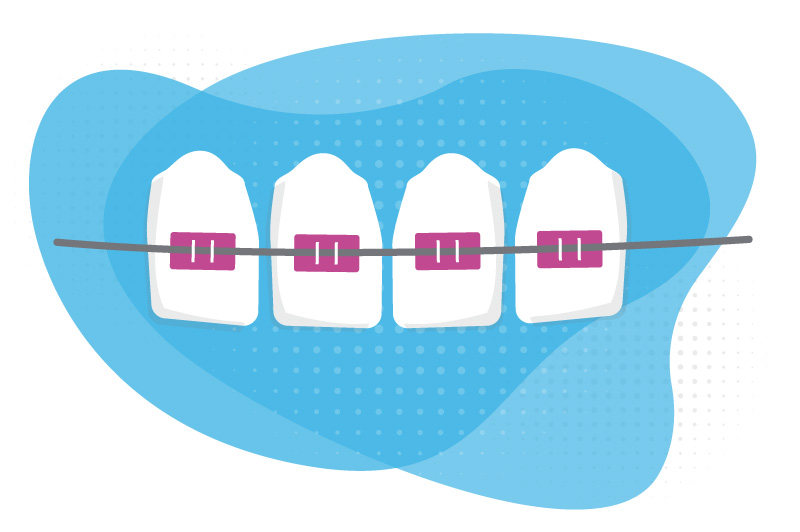What your family should know about orthodontic care

By now, your family might know what to expect at a dentist’s office. It’s a familiar routine that includes an examination, a cleaning, and (just maybe) treatment for a cavity.
An orthodontic appointment is much like a trip to the dentist, according to Dr. Megan McDougall, a Boston Children’s orthodontist. If your child’s first orthodontist appointment is on the calendar, they shouldn’t feel anxious. Assure them there won’t be any surprises because there shouldn’t be any, she says.
Here are a few other things your family should consider when seeking orthodontic care:
An orthodontist helps enhance your child’s smile
An orthodontist will work with your family to treat any dental and facial traits that might affect your child’s well-being and smile. They look at the characteristics of your child’s teeth, jaws, gums, or face (or any combination of those) to determine if they are hindering your child’s oral health and social functions.
Find a practice where orthodontists are skilled in the specialties of orthodontic care that are specific to your child’s needs. For example, at Boston Children’s, “Your child will see the team members who best treat their individual needs and wants,” Dr. McDougall says.
Missing teeth? Have an overbite? An orthodontist has a solution
An orthodontic practice should treat a variety of conditions, including:
- misaligned, crooked, crowded, extra, and missing teeth
- an overbite or an underbite
- misaligned or incorrect jaw position
Some practices will also treat oral conditions related to craniofacial anomalies, including cleft lip and palate.
Find an orthodontist that makes your child feel welcomed
A patient with special health care needs, at any age, can feel overwhelmed at a dentist or orthodontist’s office. If your child has a complex medical history, they might be intimidated by the sounds and bright lights of a medical office.
We’ve expanded!
Check out the Orthodontics Program’s new location at Boston Children’s Brookline.
Whether your child is in need of complex or routine treatment, our team of specialists is here to provide comprehensive, compassionate care.
2 Brookline Place, 8th Floor
Brookline, MA 02445
Phone: 617-355-6571
You should look for orthodontists who can understand your child’s physical and emotional needs and will work them to make sure they’re comfortable throughout treatment, Dr. McDougall says. Boston Children’s Orthodontics Program, for example, has experience treating children with a variety of complex conditions — including autism spectrum disorders, Down syndrome, and cerebral palsy — as well as children without health conditions.
Get your child the right appliance
If your child needs orthodontic treatment, they might need one or more of the following “appliances:”
- metal or ceramic braces to align teeth
- clear teeth aligners such as Invisalign
- an expander, which widens the upper jaw to better align with the lower jaw
- a habit-breaker appliance to stop thumb sucking or one to correct the tongue resting on teeth when swallowing, instead of against the roof of the mouth
“We’re not stuck in the past with the way we diagnose and treat conditions,” Dr. McDougall says. Most patients probably won’t have to bite into impression material to make a model of their mouths, something their parents likely did when they were children. And metal braces aren’t the only treatment option, she says. “A scanner can make a 3D model of a patient’s mouth. And if it’s best for a patient, we can offer clear aligners as a treatment option. The technology is advanced.”
An orthodontist should explain all steps of care
Your orthodontist should detail your child’s diagnosis and review the proposed treatment plan ahead of any treatment. Depending on the condition, the plan could have options. Whichever plan you believe best fits your child’s needs, the orthodontist should explain how to maintain the care of the braces or appliance, which foods they can and shouldn’t eat, and other tips that will help make their treatment go as easily as possible.
Treatment time varies by condition
The length of treatment depends on the condition and its extent, Dr. McDougall says. It could take as little as several months or, as seen with some braces treatment, as long as several years. Expect to visit the orthodontist every four to six weeks for checkups and adjustments.
See an orthodontist when your child is 7
The American Association of Orthodontists recommends that children be evaluated by an orthodontist by the age of 7. “It’s not necessarily that they will need to start treatment at that age, although they could if immediate intervention is needed,” Dr. McDougall says. Rather, an orthodontist can detect a problem when a child is that age and start treatment before the condition gets bigger. “Some conditions can be more difficult to treat when a child is older,” she says.
Ortho care can get boring, and your child might prefer that
Orthodontic treatment won’t be scary or mysterious if an orthodontist works closely with your child and family, explaining every step of the process along the way and always seeking your input. “It’s mostly just going to be boring because patients have to sit there with their mouths open while we install the appliance or braces,” Dr. McDougall says.
Learn more about the Orthodontics Program.
Related Posts :
-

Amanda gets the smile she always wanted — just in time for college
One of the first things you’ll notice about Amanda Altemus is her big smile. She’s a proud Clemson ...
-

Cavities are no trick: How to balance Halloween candy with healthy teeth
Believe it or not, dentists don’t dislike Halloween. They don’t secretly wish for kids to not eat candy. ...
-

Parents: Start dental care early for children with special health care needs
This is the first of a two-part series offering dental tips to the parents of children with special health care ...
-

Logan shows off ‘big personality’ while overcoming cleft lip and palate
Three-year-old Logan Hatfield doesn’t simply ask to watch “The Lion King.” He lets out a loud roar and follows ...





